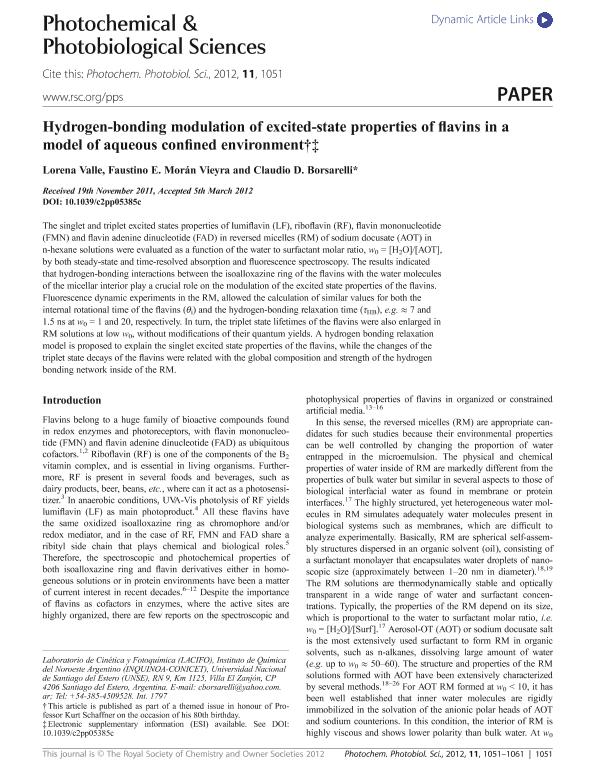Artículo
Hydrogen-bonding modulation of excited-state properties of flavins in a model of aqueous confined environment
Fecha de publicación:
06/2012
Editorial:
Royal Society of Chemistry
Revista:
Photochemical and Photobiological Sciences
ISSN:
1474-905X
Idioma:
Inglés
Tipo de recurso:
Artículo publicado
Clasificación temática:
Resumen
The singlet and triplet excited states properties of lumiflavin (LF), riboflavin (RF), flavin mononucleotide (FMN) and flavin adenine dinucleotide (FAD) in reversed micelles (RM) of sodium docusate (AOT) in n-hexane solutions were evaluated as a function of the water to surfactant molar ratio, w0 = [H2O]/[AOT], by both steady-state and time-resolved absorption and fluorescence spectroscopy. The results indicated that hydrogen-bonding interactions between the isoalloxazine ring of the flavins with the water molecules of the micellar interior play a crucial role on the modulation of the excited state properties of the flavins. Fluorescence dynamic experiments in the RM, allowed the calculation of similar values for both the internal rotational time of the flavins (θi) and the hydrogen-bonding relaxation time (τHB), e.g. ≈ 7 and 1.5 ns at w0 = 1 and 20, respectively. In turn, the triplet state lifetimes of the flavins were also enlarged in RM solutions at low w0, without modifications of their quantum yields. A hydrogen bonding relaxation model is proposed to explain the singlet excited state properties of the flavins, while the changes of the triplet state decays of the flavins were related with the global composition and strength of the hydrogen bonding network inside of the RM.
Palabras clave:
HIDROGEN-BONDING
,
FLAVINS
,
REVERSE MICELLES
Archivos asociados
Licencia
Identificadores
Colecciones
Articulos(INQUINOA)
Articulos de INST.DE QUIMICA DEL NOROESTE
Articulos de INST.DE QUIMICA DEL NOROESTE
Articulos(SEDE CENTRAL)
Articulos de SEDE CENTRAL
Articulos de SEDE CENTRAL
Citación
Valle, Lorena; Moran Vieyra, Faustino Eduardo; Borsarelli, Claudio Darío; Hydrogen-bonding modulation of excited-state properties of flavins in a model of aqueous confined environment; Royal Society of Chemistry; Photochemical and Photobiological Sciences; 11; 6; 6-2012; 1051-1061
Compartir
Altmétricas




